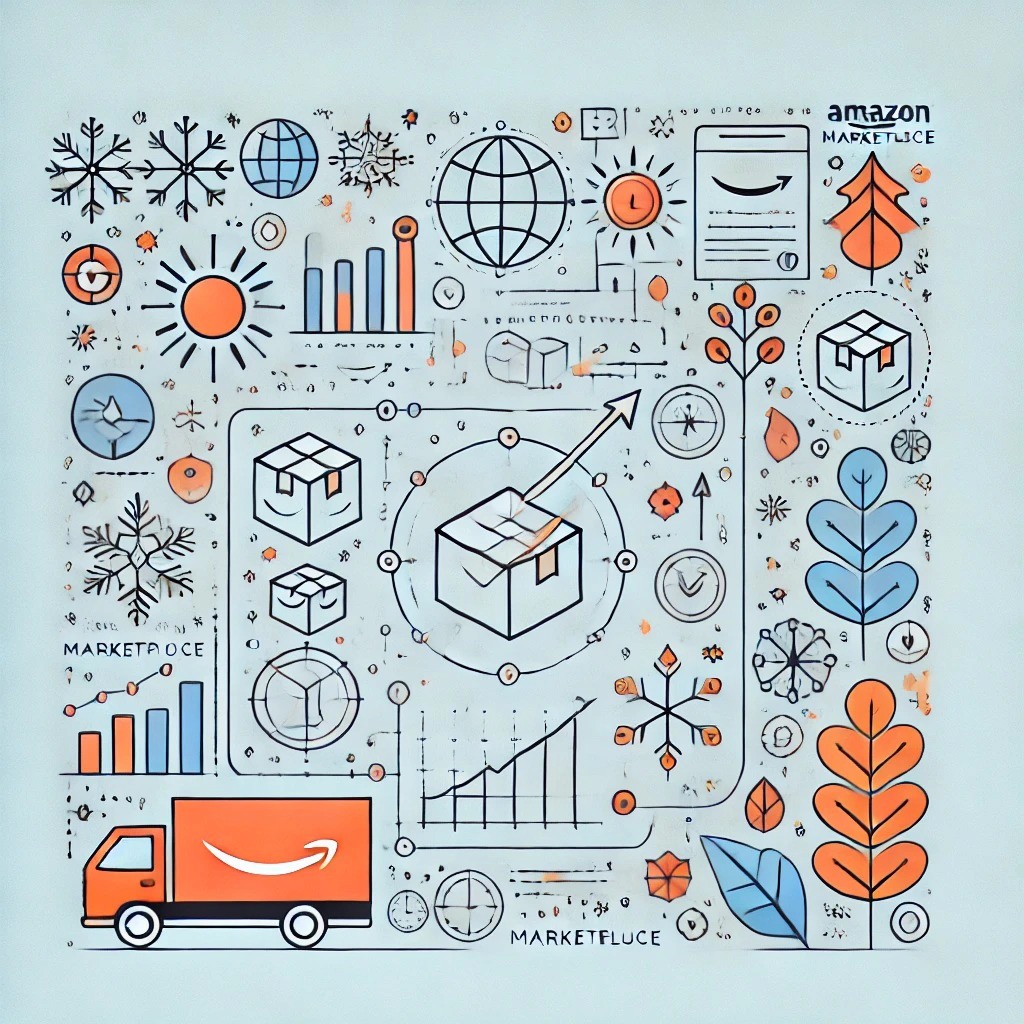Back to Page
Amazon
Struggling with Seasonal Sales on Amazon? Here’s the Blueprint for Success
Struggling with Seasonal Sales on Amazon? Here’s the Blueprint for Success


Back to Page
Amazon
Struggling with Seasonal Sales on Amazon? Here’s the Blueprint for Success

Seasonal fluctuations can make or break an Amazon seller's success. Whether it's the holiday rush or the summer lull, navigating these peaks and valleys requires a strategic approach. In this blog, we'll look into the blueprint for mastering seasonal sales on Amazon, helping you capitalize on the highs and mitigate the lows.
What is a seasonal product?

Seasonal products are typically available or in demand during only part of the year. From holiday decorations and costumes during Halloween and Christmas to gardening tools during spring and beach gear during summer, these items see their demand wax and wane with the seasons, trends, and customer behavior, allowing you to follow their money trail.
As the biggest online retailer outside of China, Amazon can offer a sizable boon to sellers who can tap into this massive commerce river. Seasonal products are the equatorial regions of this river—violent and tricky currents requiring you to be more dynamic in your strategy and more strategic in your game plan on Amazon whether you’re a brand owner or FBA and/or FBM seller.
Examples of seasonal products
Products related to the four seasons
1. Spring seasonal products are usually associated with spring activities and the fair to warm weather. Spring is a time of rejuvenation, rebirth, and shedding the cold drabness of winter. Choose a product that customers will want to get them in the mood for warmer days and go outside after staying in for a few months.
Spring dresses for women
Gardening equipment
Flower pots
Sun hats for women
Bird feeders
2. Summer seasonal products are usually associated with summer activities and the hot, sunny weather. Summer is the season for vacation, camping, going out for fun in the sun, and not worrying about school. Choose a product that plays into customers’ desire to get out and do fun activities, but also keep cool during the really hot times.
Swimsuits
Camping gear
Beach umbrellas
Sunglasses
Hiking boots
3. Autumn seasonal products are usually associated with autumn activities and cool weather. Autumn is a time of coming together from the beginning of the holiday season, the first football games, and a new school year. Choose a product that reminds customers of the joys of this fan-favorite season.
Lawn rakes
Back-to-School items
Pumpkin spice flavoring
Cool-weather fleece
Tall boots for women
4. Winter seasonal products are usually associated with winter activities and cold weather. Winter is a time of extreme cold, but also offers many fun activities for winter sporting enthusiasts, as well as many holidays. Choose a product that either makes a good gift to give or keeps people shielded from the cold.
Skiing equipment
Heavy parka coats
Tire chains
Snow shovels
Leather gloves for men
A “seasonal” item doesn’t always mean a specific season
While many seasonal products have to do with one of the four major seasons, the majority of the seasonal products that are bought for a limited time don’t have to do with spring, summer, winter, and autumn.
For example, many items cater to particular crowds at particular times of the year, including:
Holidays: These products are typically used to celebrate a certain holiday and may only be popular in the month(s) leading up to the holiday. A smart move is to make these items available at least one month before the holiday itself.
Christmas trees and decor
St. Patrick’s Day decor
Valentine’s candy boxes
Halloween decorations
Costumes for adults and kids
Holiday Decor
Holiday gift wrap
Holiday gift sets
Special Occasions: These products also celebrate popular occasions that aren’t official holidays per se but are treated as such. These items tend to celebrate occasions that are annual but happen within the same general time frame.
Graduation cards
Mother’s and Father’s Day cards
Sporting event products
Benefits and risks of selling a seasonal product
Benefits:
Increasing revenues: Following the example of other sellers, products related to Christmas, for example, often sell like hotcakes during the holiday season, giving sellers a big uptick in their sales.
Predictability of sale: Because they’re seasonal, you can plan your inventory and watch your business explode every summer on cue.
As a seller, you can use data from previous purchases from other channels, conducting market research like online product tracking to learn about the products that have sold well, their prices, and their quantities. By doing so, you can set an inventory plan and a marketing plan in place to hit that demand with the best product, best price, and best listing.
Risks:
Inventory management challenges: Managing inventory for seasonal products can be tricky. Overestimating demand can leave you with unsold stock that ties up capital, while underestimating can lead to missed sales opportunities.
Increased competition: Many sellers jump on the seasonal bandwagon, leading to fierce competition. Standing out among the crowd requires clever marketing and competitive pricing strategies.
Dependence on the right timing: Timing is everything with seasonal products. A delay in stock arrival or a marketing campaign can mean missing the peak demand period, significantly impacting potential sales.
A thorough knowledge of these upsides and downsides is key for any seller considering adding seasonal products to their Amazon portfolio. With careful planning and strategic execution, the rewards can far outweigh the challenges.
Tips for Selling Seasonal Products on Amazon
Selling seasonal products on Amazon requires a mix of foresight, strategy, and timing. Here's a detailed look at how to make the most of your seasonal product listings on Amazon:
#1. Research and planning

Start by researching which seasonal products align with your brand and have a proven track record of demand. Utilize Amazon product research to analyze sales trends and gather insights on competition and market demand.
#2. Inventory management

Based on your research, plan your inventory carefully. With products that have a long sales window, merchant fulfillment might be a good choice, as it gives you more control in selecting the right shipping partner. Getting your stock to Amazon early in the season is key for products with a short sales window. Remember that Amazon's FBA program can handle all logistics and ensure faster delivery to customers.
#3. Optimizing listings

When creating seasonal product listings, make sure you do thorough product listing optimization. In addition to details of the product, highlight any seasonal relevance in the listing. Incorporate Amazon product keyword research that is related to the season, holiday, or event so that it picks up more organic visibility. Adding high-quality images and a detailed product description, together will surely make your listing stand out.
#4. Dynamic pricing

On Amazon, getting a place in the Amazon Featured Offer (formerly Buy Box) can make a tremendous difference in your ability to outsell the competition, and pricing is one of the most important factors in the equation. Closely follow the strategies of your competitors and consider using an Amazon research tool that will adjust yours in response to changes in the market.
#5. Promotion and marketing

Amazon’s advertising tools, such as Sponsored Products and Sponsored Brands, can be valuable in raising your product’s visibility with the surge of shoppers during the holiday season. Plan your campaigns well in advance with capable Amazon advertising experts and make sure you’ve budgeted enough to be very aggressive during the peak months of the season.
#6. Customer service

Deliver exceptional customer service to earn rave reviews and build lasting relationships with shoppers. Respond promptly to inquiries, address customer concerns proactively, and ensure smooth order fulfillment and delivery. Positive feedback and word-of-mouth recommendations can significantly impact your sales performance, especially during peak seasons.
#7. Post-season analysis

The effort to improve your seasonal sales never truly ends. After the dust has settled on the sales year, perform a thorough analysis of your performance: What did you do well, and what needs improvement? The answers will stand you in good stead as you prepare to do the whole thing over again the following season.
By carefully following these tips, you’ll be well-positioned to maximize your chances of success while selling seasonal products on Amazon. As markets fluctuate and the purchasing priorities of consumers evolve, the ability to maintain a disciplined approach, adapt to change, and stay informed on developments that can impact your bottom line will offer the greatest opportunities for sustaining and helping your business grow.
Conclusion
Seasonal products are an excellent opportunity for Amazon Sellers to capitalize on periods of real high demand. They present challenges of their own, including the delicate business of inventory management and a bout of new, fierce competition, but with benefits that can be substantial. An understanding of the ins and outs of seasonal products – what they are, the associated benefits and potential risks in selling them, and the execution of strategic tips for success – can go a long way toward realizing the type of sales numbers that can grow your business.
Selling seasonal products requires careful planning, strategic maneuvering, and the consistent ability to pivot with market trends. And precisely that is where eStore Factory’s effective Amazon marketing services can help you stay ahead of the curve. With us, sellers can successfully navigate the seasonal waves that frequent Amazon’s ocean, and make the most of every season.
Seasonal fluctuations can make or break an Amazon seller's success. Whether it's the holiday rush or the summer lull, navigating these peaks and valleys requires a strategic approach. In this blog, we'll look into the blueprint for mastering seasonal sales on Amazon, helping you capitalize on the highs and mitigate the lows.
What is a seasonal product?

Seasonal products are typically available or in demand during only part of the year. From holiday decorations and costumes during Halloween and Christmas to gardening tools during spring and beach gear during summer, these items see their demand wax and wane with the seasons, trends, and customer behavior, allowing you to follow their money trail.
As the biggest online retailer outside of China, Amazon can offer a sizable boon to sellers who can tap into this massive commerce river. Seasonal products are the equatorial regions of this river—violent and tricky currents requiring you to be more dynamic in your strategy and more strategic in your game plan on Amazon whether you’re a brand owner or FBA and/or FBM seller.
Examples of seasonal products
Products related to the four seasons
1. Spring seasonal products are usually associated with spring activities and the fair to warm weather. Spring is a time of rejuvenation, rebirth, and shedding the cold drabness of winter. Choose a product that customers will want to get them in the mood for warmer days and go outside after staying in for a few months.
Spring dresses for women
Gardening equipment
Flower pots
Sun hats for women
Bird feeders
2. Summer seasonal products are usually associated with summer activities and the hot, sunny weather. Summer is the season for vacation, camping, going out for fun in the sun, and not worrying about school. Choose a product that plays into customers’ desire to get out and do fun activities, but also keep cool during the really hot times.
Swimsuits
Camping gear
Beach umbrellas
Sunglasses
Hiking boots
3. Autumn seasonal products are usually associated with autumn activities and cool weather. Autumn is a time of coming together from the beginning of the holiday season, the first football games, and a new school year. Choose a product that reminds customers of the joys of this fan-favorite season.
Lawn rakes
Back-to-School items
Pumpkin spice flavoring
Cool-weather fleece
Tall boots for women
4. Winter seasonal products are usually associated with winter activities and cold weather. Winter is a time of extreme cold, but also offers many fun activities for winter sporting enthusiasts, as well as many holidays. Choose a product that either makes a good gift to give or keeps people shielded from the cold.
Skiing equipment
Heavy parka coats
Tire chains
Snow shovels
Leather gloves for men
A “seasonal” item doesn’t always mean a specific season
While many seasonal products have to do with one of the four major seasons, the majority of the seasonal products that are bought for a limited time don’t have to do with spring, summer, winter, and autumn.
For example, many items cater to particular crowds at particular times of the year, including:
Holidays: These products are typically used to celebrate a certain holiday and may only be popular in the month(s) leading up to the holiday. A smart move is to make these items available at least one month before the holiday itself.
Christmas trees and decor
St. Patrick’s Day decor
Valentine’s candy boxes
Halloween decorations
Costumes for adults and kids
Holiday Decor
Holiday gift wrap
Holiday gift sets
Special Occasions: These products also celebrate popular occasions that aren’t official holidays per se but are treated as such. These items tend to celebrate occasions that are annual but happen within the same general time frame.
Graduation cards
Mother’s and Father’s Day cards
Sporting event products
Benefits and risks of selling a seasonal product
Benefits:
Increasing revenues: Following the example of other sellers, products related to Christmas, for example, often sell like hotcakes during the holiday season, giving sellers a big uptick in their sales.
Predictability of sale: Because they’re seasonal, you can plan your inventory and watch your business explode every summer on cue.
As a seller, you can use data from previous purchases from other channels, conducting market research like online product tracking to learn about the products that have sold well, their prices, and their quantities. By doing so, you can set an inventory plan and a marketing plan in place to hit that demand with the best product, best price, and best listing.
Risks:
Inventory management challenges: Managing inventory for seasonal products can be tricky. Overestimating demand can leave you with unsold stock that ties up capital, while underestimating can lead to missed sales opportunities.
Increased competition: Many sellers jump on the seasonal bandwagon, leading to fierce competition. Standing out among the crowd requires clever marketing and competitive pricing strategies.
Dependence on the right timing: Timing is everything with seasonal products. A delay in stock arrival or a marketing campaign can mean missing the peak demand period, significantly impacting potential sales.
A thorough knowledge of these upsides and downsides is key for any seller considering adding seasonal products to their Amazon portfolio. With careful planning and strategic execution, the rewards can far outweigh the challenges.
Tips for Selling Seasonal Products on Amazon
Selling seasonal products on Amazon requires a mix of foresight, strategy, and timing. Here's a detailed look at how to make the most of your seasonal product listings on Amazon:
#1. Research and planning

Start by researching which seasonal products align with your brand and have a proven track record of demand. Utilize Amazon product research to analyze sales trends and gather insights on competition and market demand.
#2. Inventory management

Based on your research, plan your inventory carefully. With products that have a long sales window, merchant fulfillment might be a good choice, as it gives you more control in selecting the right shipping partner. Getting your stock to Amazon early in the season is key for products with a short sales window. Remember that Amazon's FBA program can handle all logistics and ensure faster delivery to customers.
#3. Optimizing listings

When creating seasonal product listings, make sure you do thorough product listing optimization. In addition to details of the product, highlight any seasonal relevance in the listing. Incorporate Amazon product keyword research that is related to the season, holiday, or event so that it picks up more organic visibility. Adding high-quality images and a detailed product description, together will surely make your listing stand out.
#4. Dynamic pricing

On Amazon, getting a place in the Amazon Featured Offer (formerly Buy Box) can make a tremendous difference in your ability to outsell the competition, and pricing is one of the most important factors in the equation. Closely follow the strategies of your competitors and consider using an Amazon research tool that will adjust yours in response to changes in the market.
#5. Promotion and marketing

Amazon’s advertising tools, such as Sponsored Products and Sponsored Brands, can be valuable in raising your product’s visibility with the surge of shoppers during the holiday season. Plan your campaigns well in advance with capable Amazon advertising experts and make sure you’ve budgeted enough to be very aggressive during the peak months of the season.
#6. Customer service

Deliver exceptional customer service to earn rave reviews and build lasting relationships with shoppers. Respond promptly to inquiries, address customer concerns proactively, and ensure smooth order fulfillment and delivery. Positive feedback and word-of-mouth recommendations can significantly impact your sales performance, especially during peak seasons.
#7. Post-season analysis

The effort to improve your seasonal sales never truly ends. After the dust has settled on the sales year, perform a thorough analysis of your performance: What did you do well, and what needs improvement? The answers will stand you in good stead as you prepare to do the whole thing over again the following season.
By carefully following these tips, you’ll be well-positioned to maximize your chances of success while selling seasonal products on Amazon. As markets fluctuate and the purchasing priorities of consumers evolve, the ability to maintain a disciplined approach, adapt to change, and stay informed on developments that can impact your bottom line will offer the greatest opportunities for sustaining and helping your business grow.
Conclusion
Seasonal products are an excellent opportunity for Amazon Sellers to capitalize on periods of real high demand. They present challenges of their own, including the delicate business of inventory management and a bout of new, fierce competition, but with benefits that can be substantial. An understanding of the ins and outs of seasonal products – what they are, the associated benefits and potential risks in selling them, and the execution of strategic tips for success – can go a long way toward realizing the type of sales numbers that can grow your business.
Selling seasonal products requires careful planning, strategic maneuvering, and the consistent ability to pivot with market trends. And precisely that is where eStore Factory’s effective Amazon marketing services can help you stay ahead of the curve. With us, sellers can successfully navigate the seasonal waves that frequent Amazon’s ocean, and make the most of every season.
Seasonal fluctuations can make or break an Amazon seller's success. Whether it's the holiday rush or the summer lull, navigating these peaks and valleys requires a strategic approach. In this blog, we'll look into the blueprint for mastering seasonal sales on Amazon, helping you capitalize on the highs and mitigate the lows.
What is a seasonal product?

Seasonal products are typically available or in demand during only part of the year. From holiday decorations and costumes during Halloween and Christmas to gardening tools during spring and beach gear during summer, these items see their demand wax and wane with the seasons, trends, and customer behavior, allowing you to follow their money trail.
As the biggest online retailer outside of China, Amazon can offer a sizable boon to sellers who can tap into this massive commerce river. Seasonal products are the equatorial regions of this river—violent and tricky currents requiring you to be more dynamic in your strategy and more strategic in your game plan on Amazon whether you’re a brand owner or FBA and/or FBM seller.
Examples of seasonal products
Products related to the four seasons
1. Spring seasonal products are usually associated with spring activities and the fair to warm weather. Spring is a time of rejuvenation, rebirth, and shedding the cold drabness of winter. Choose a product that customers will want to get them in the mood for warmer days and go outside after staying in for a few months.
Spring dresses for women
Gardening equipment
Flower pots
Sun hats for women
Bird feeders
2. Summer seasonal products are usually associated with summer activities and the hot, sunny weather. Summer is the season for vacation, camping, going out for fun in the sun, and not worrying about school. Choose a product that plays into customers’ desire to get out and do fun activities, but also keep cool during the really hot times.
Swimsuits
Camping gear
Beach umbrellas
Sunglasses
Hiking boots
3. Autumn seasonal products are usually associated with autumn activities and cool weather. Autumn is a time of coming together from the beginning of the holiday season, the first football games, and a new school year. Choose a product that reminds customers of the joys of this fan-favorite season.
Lawn rakes
Back-to-School items
Pumpkin spice flavoring
Cool-weather fleece
Tall boots for women
4. Winter seasonal products are usually associated with winter activities and cold weather. Winter is a time of extreme cold, but also offers many fun activities for winter sporting enthusiasts, as well as many holidays. Choose a product that either makes a good gift to give or keeps people shielded from the cold.
Skiing equipment
Heavy parka coats
Tire chains
Snow shovels
Leather gloves for men
A “seasonal” item doesn’t always mean a specific season
While many seasonal products have to do with one of the four major seasons, the majority of the seasonal products that are bought for a limited time don’t have to do with spring, summer, winter, and autumn.
For example, many items cater to particular crowds at particular times of the year, including:
Holidays: These products are typically used to celebrate a certain holiday and may only be popular in the month(s) leading up to the holiday. A smart move is to make these items available at least one month before the holiday itself.
Christmas trees and decor
St. Patrick’s Day decor
Valentine’s candy boxes
Halloween decorations
Costumes for adults and kids
Holiday Decor
Holiday gift wrap
Holiday gift sets
Special Occasions: These products also celebrate popular occasions that aren’t official holidays per se but are treated as such. These items tend to celebrate occasions that are annual but happen within the same general time frame.
Graduation cards
Mother’s and Father’s Day cards
Sporting event products
Benefits and risks of selling a seasonal product
Benefits:
Increasing revenues: Following the example of other sellers, products related to Christmas, for example, often sell like hotcakes during the holiday season, giving sellers a big uptick in their sales.
Predictability of sale: Because they’re seasonal, you can plan your inventory and watch your business explode every summer on cue.
As a seller, you can use data from previous purchases from other channels, conducting market research like online product tracking to learn about the products that have sold well, their prices, and their quantities. By doing so, you can set an inventory plan and a marketing plan in place to hit that demand with the best product, best price, and best listing.
Risks:
Inventory management challenges: Managing inventory for seasonal products can be tricky. Overestimating demand can leave you with unsold stock that ties up capital, while underestimating can lead to missed sales opportunities.
Increased competition: Many sellers jump on the seasonal bandwagon, leading to fierce competition. Standing out among the crowd requires clever marketing and competitive pricing strategies.
Dependence on the right timing: Timing is everything with seasonal products. A delay in stock arrival or a marketing campaign can mean missing the peak demand period, significantly impacting potential sales.
A thorough knowledge of these upsides and downsides is key for any seller considering adding seasonal products to their Amazon portfolio. With careful planning and strategic execution, the rewards can far outweigh the challenges.
Tips for Selling Seasonal Products on Amazon
Selling seasonal products on Amazon requires a mix of foresight, strategy, and timing. Here's a detailed look at how to make the most of your seasonal product listings on Amazon:
#1. Research and planning

Start by researching which seasonal products align with your brand and have a proven track record of demand. Utilize Amazon product research to analyze sales trends and gather insights on competition and market demand.
#2. Inventory management

Based on your research, plan your inventory carefully. With products that have a long sales window, merchant fulfillment might be a good choice, as it gives you more control in selecting the right shipping partner. Getting your stock to Amazon early in the season is key for products with a short sales window. Remember that Amazon's FBA program can handle all logistics and ensure faster delivery to customers.
#3. Optimizing listings

When creating seasonal product listings, make sure you do thorough product listing optimization. In addition to details of the product, highlight any seasonal relevance in the listing. Incorporate Amazon product keyword research that is related to the season, holiday, or event so that it picks up more organic visibility. Adding high-quality images and a detailed product description, together will surely make your listing stand out.
#4. Dynamic pricing

On Amazon, getting a place in the Amazon Featured Offer (formerly Buy Box) can make a tremendous difference in your ability to outsell the competition, and pricing is one of the most important factors in the equation. Closely follow the strategies of your competitors and consider using an Amazon research tool that will adjust yours in response to changes in the market.
#5. Promotion and marketing

Amazon’s advertising tools, such as Sponsored Products and Sponsored Brands, can be valuable in raising your product’s visibility with the surge of shoppers during the holiday season. Plan your campaigns well in advance with capable Amazon advertising experts and make sure you’ve budgeted enough to be very aggressive during the peak months of the season.
#6. Customer service

Deliver exceptional customer service to earn rave reviews and build lasting relationships with shoppers. Respond promptly to inquiries, address customer concerns proactively, and ensure smooth order fulfillment and delivery. Positive feedback and word-of-mouth recommendations can significantly impact your sales performance, especially during peak seasons.
#7. Post-season analysis

The effort to improve your seasonal sales never truly ends. After the dust has settled on the sales year, perform a thorough analysis of your performance: What did you do well, and what needs improvement? The answers will stand you in good stead as you prepare to do the whole thing over again the following season.
By carefully following these tips, you’ll be well-positioned to maximize your chances of success while selling seasonal products on Amazon. As markets fluctuate and the purchasing priorities of consumers evolve, the ability to maintain a disciplined approach, adapt to change, and stay informed on developments that can impact your bottom line will offer the greatest opportunities for sustaining and helping your business grow.
Conclusion
Seasonal products are an excellent opportunity for Amazon Sellers to capitalize on periods of real high demand. They present challenges of their own, including the delicate business of inventory management and a bout of new, fierce competition, but with benefits that can be substantial. An understanding of the ins and outs of seasonal products – what they are, the associated benefits and potential risks in selling them, and the execution of strategic tips for success – can go a long way toward realizing the type of sales numbers that can grow your business.
Selling seasonal products requires careful planning, strategic maneuvering, and the consistent ability to pivot with market trends. And precisely that is where eStore Factory’s effective Amazon marketing services can help you stay ahead of the curve. With us, sellers can successfully navigate the seasonal waves that frequent Amazon’s ocean, and make the most of every season.






